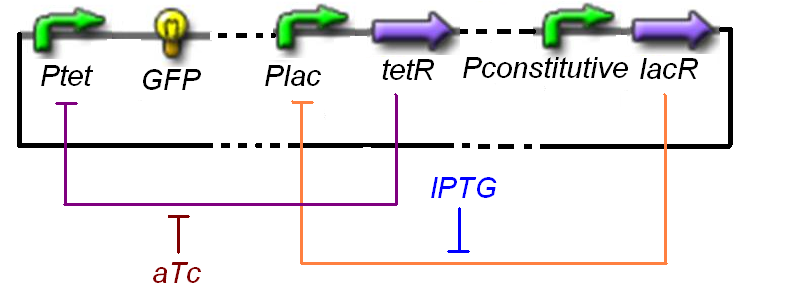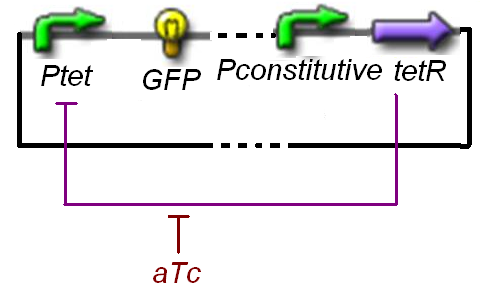Team:Paris/Modeling/f2
From 2008.igem.org
(Difference between revisions)
| Line 5: | Line 5: | ||
Exactly as for the binding of IPTG on LacR (see [[Team:Paris/Modeling/estimation#how_to_control_the_concentration_of_the_transcription_factor_.3F|TF concentration control]]), leading to a lowered inhibition of ''Plac'', aTc binds to TetR. So, after having determinated the Hill function [expr.''Ptet''] = ƒ2(TetR) = ƒ2aux(IPTG), we can study [expr.''Ptet''] = ƒ2ter([TetR],[aTc]), and determine by calcul [TetR<sub>active</sub>] = ƒ2bis(aTc) = f2<sup>-1</sup>([expr.''Ptet'']), to endly give an analytical expression of ƒ2ter = ƒ2οƒ2bis | Exactly as for the binding of IPTG on LacR (see [[Team:Paris/Modeling/estimation#how_to_control_the_concentration_of_the_transcription_factor_.3F|TF concentration control]]), leading to a lowered inhibition of ''Plac'', aTc binds to TetR. So, after having determinated the Hill function [expr.''Ptet''] = ƒ2(TetR) = ƒ2aux(IPTG), we can study [expr.''Ptet''] = ƒ2ter([TetR],[aTc]), and determine by calcul [TetR<sub>active</sub>] = ƒ2bis(aTc) = f2<sup>-1</sup>([expr.''Ptet'']), to endly give an analytical expression of ƒ2ter = ƒ2οƒ2bis | ||
| - | + | ||
Otherwise, if we find in the litterature the dissociation constant of the reaction aTc + TetR⇄ aTc_TetR, we could determine by calculus the amount of free TetR, function of the expression of a known constitutive promoter before ''tetR'' and of the added aTc. In this way, we just have to study [expr.''Ptet''] = ƒ2(TetR<sub>free</sub>). | Otherwise, if we find in the litterature the dissociation constant of the reaction aTc + TetR⇄ aTc_TetR, we could determine by calculus the amount of free TetR, function of the expression of a known constitutive promoter before ''tetR'' and of the added aTc. In this way, we just have to study [expr.''Ptet''] = ƒ2(TetR<sub>free</sub>). | ||
| + | |||
| + | [[Image:f2alt.png]] | ||
Revision as of 18:51, 12 August 2008
No particular strain.
Exactly as for the binding of IPTG on LacR (see TF concentration control), leading to a lowered inhibition of Plac, aTc binds to TetR. So, after having determinated the Hill function [expr.Ptet] = ƒ2(TetR) = ƒ2aux(IPTG), we can study [expr.Ptet] = ƒ2ter([TetR],[aTc]), and determine by calcul [TetRactive] = ƒ2bis(aTc) = f2-1([expr.Ptet]), to endly give an analytical expression of ƒ2ter = ƒ2οƒ2bis
Otherwise, if we find in the litterature the dissociation constant of the reaction aTc + TetR⇄ aTc_TetR, we could determine by calculus the amount of free TetR, function of the expression of a known constitutive promoter before tetR and of the added aTc. In this way, we just have to study [expr.Ptet] = ƒ2(TetRfree).
 "
"

